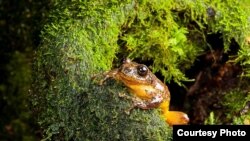Researchers in India say they’ve identified a frog long thought to have been extinct.
Last spotted in the wild in 1870, the Frankixalus jerdonii, a kind of tree frog, lives in the foothills of the Himalayas in India’s West Bengal state.
The golf-ball size frog was rediscovered during a 2007 expedition led by Indian biologist Sathyabhama Das Biju.
"We heard a full musical orchestra coming from the tree tops. It was magical. Of course we had to investigate," he told the BBC.
Using DNA analysis, Biju also came to the conclusion that the frog’s “enigmatic lineage” means the tiny amphibian belongs to a new genus.
Biju said that during fieldwork, researchers saw the frog exhibiting some unusual behavior, “including tadpoles that feed on the mother’s eggs.”
The tadpoles each had "3-19 eggs in their intestines," according to the study. They also did not have teeth rows, further differentiating them from other species.
Study co-author Ines Van Bocxlaer told National Geographic that "the frog's DNA, odd feeding behavior and anatomy shows the species 'represents a deep evolutionary split in tree frog evolution.' "
"This genus probably remained unnoticed because of its secretive life in high canopy tree holes," said Biju, noting the frog is different from other tree frog genera “in breeding, egg laying, and development.”
Furthermore, the frog’s external appearance and skeletal shape add to its distinctiveness.
The researchers note that the frog’s future is uncertain.
"Since the new genus shows remarkable parental care behavior with specific microhabitat requirements for their survival, populations discovered from highly disturbed forests are already facing extinction threats," said Biju.
The remoteness of the frog’s habitat is the most likely reason it hadn’t been seen in so long. Additionally, the tree holes in which it lives are up to 6 meters above the ground, according to the BBC.
The Old World tree frog family currently contains over 380 species, researchers said.











